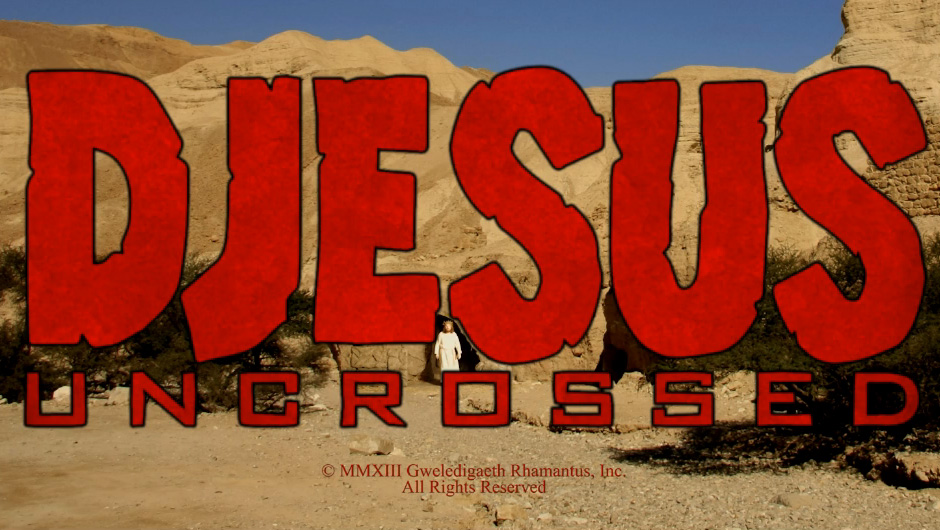I’ve been looking forward to writing this post about one of my favorite spots of this season, “Djesus Uncrossed”. First I should acknowledge that this was, by far, the most controversial spot I’ve been a part of in my history with the show. Religious groups were infuriated while pop artists were inspired to create fan-art.
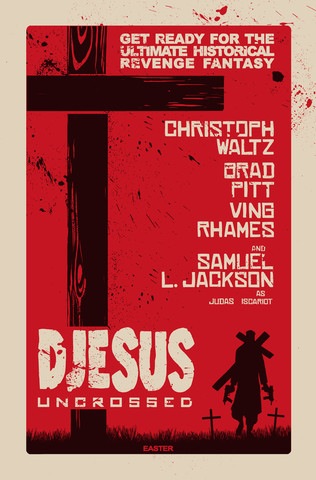
Original fan-art created by Isaac Bidwell, available at Gallery1988.
As someone who spent the first 12 years of his education at Jesuit Catholic schools and the last 14 seasons at SNL, I thought the script was an inspired and overdue satire of Quentin Tarantino movies (and not a deliberate satire of Christianity). On that note, I think this review by TV critic James Poniewozik sums it up perfectly: (“Djesus Uncrossed”: Grievance, and How Satire Actually Works”):
“Djesus Uncrossed” is unmistakably a satire. A satire of Quentin Tarantino, not Jesus. It’s Tarantino’s violence, his gore, his taste for folksy mayhem and liberal doses of buckshot and the n-word that’s exaggerated here and made ludicrous…On the other hand, the skit plays off Jesus’s most positive associations: forgiveness, peaceability, love. In fact, the joke can’t work any other way–the entire premise is that Tarantino is so bloodthirsty a moviemaker that he’d even turn Jesus into an action-movie killer. It’s only funny if it reinforces the idea that the actual Jesus, outside the skit, is/was the antithesis of Djesus.”
With that said, I understand that some viewers unfortunately find this spot offensive regardless, so I’d also like to point out that this discussion is specifically about the incredibly difficult technical feat involved in producing this entire spot in one extremely long, never-ending day.
CUT TO:
9AM – THURSDAY MORNING, 30 ROCK
I’m reading the script for the first time, thinking – “We’re supposed to shoot all of this…TOMORROW?” The script was written by Zach Kanin and Colin Jost – two of my favorite writers at the show – and the scale of the spot was massive. It was essentially: Ancient Rome and the Holy Land, to be shot in New York City with a few hours of scouting. On top of that, it was a mashup of Tarantino movies, starring Tarantino’s own Oscar-winning regular and Host of the show, Christoph Waltz — which adds another layer of complexity (and fun!). Tarantino’s cinematographer is Robert Richardson, ASC – one of my all-time biggest influences. For me, this was a crazy challenge that I couldn’t wait to take on.
Step One was breaking down the script with director Rhys Thomas and the team, trying to get our heads around how to approach so many locations. We considered finding a Donald Trump-esque ornate interior that could double as the Roman interior sets but quickly decided that we’d be left SOL for all the other locations. Our only move was to build most of the locations on stage. However, we knew that if we could shoot a few scenes outside it would really upscale the whole spot. We set out to find exterior locations for the Pontius Pilate / Roman Balcony location as well as the Basterds / St. Peter sequence. Rhys had the inspired idea to check out the Brooklyn Navy Yard – which includes a whole hillside of disused WWII barracks that, after years of abandonment, look strikingly like a bombed-out European town, a la “Inglorious Basterds”. The huge coup was in finding a grand old Admiral’s office building featuring stone columns that – with a bit of a clean-up and set dressing – could be turned into Pontius Pilate’s balcony. Not only was the Brooklyn Navy Yard a pretty remarkable “this is definitely NOT New York” exterior, but it was a stone’s throw to Steiner Studios – one of the premiere sound stages in New York, where we could build our sets. Boo-ya!
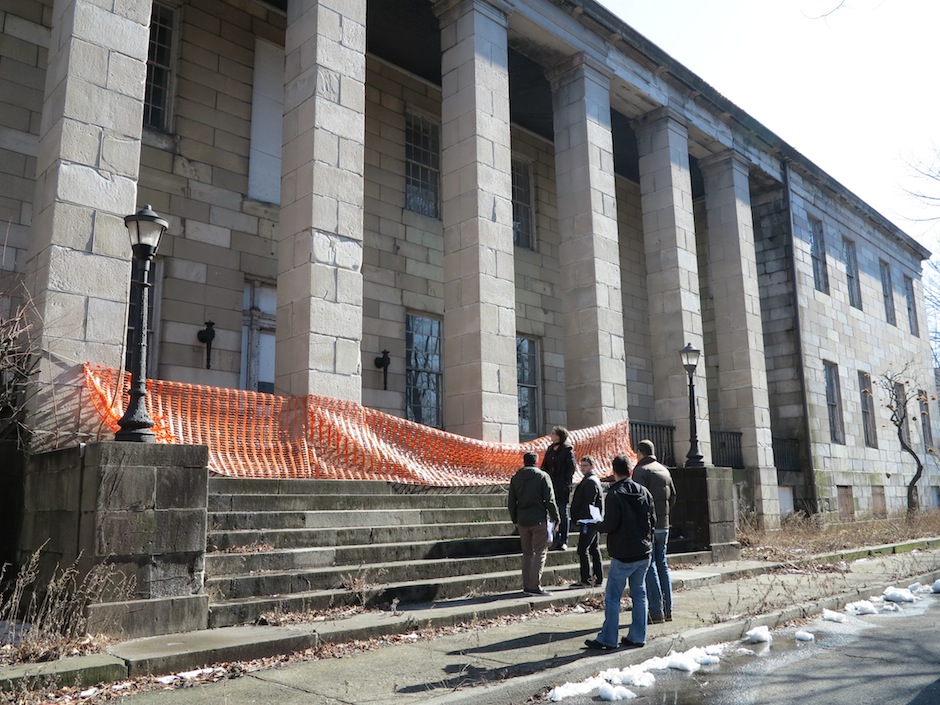
Location scouting Brooklyn-for-Rome
With the location/stage figured out, Art Director Andrea Purcigliotti went to work designing all the sets and Rhys and I started building our shotlist. Since this was a send-up of the entire Tarantino revenge-thriller canon, we had to ask ourselves: what are the most signature Tarantino shots/visuals that will sell this satire? I had just seen “Django Unchained” and I ended up speed-viewing “Kill Bill Vol 1” and “Inglorious Basterds”, trying to pull out visual touchstones like snap-zooms, large soft key lights, bold primary colors, extreme angle / three-point perspective shots…and a whole lot of blood.
Another thing that I already knew about emulating the look of a Bob Richardson movie: that guy lives on the crane. Seriously: just Google Image Search “Robert Richardson” — in literally every photo he’s either accepting an Oscar or sitting on a camera crane. Bad ass. But we almost never rent cranes at SNL. A camera crane is a great tool if you have the time to design and execute proper crane shots – but that rarely happens at SNL. Well, despite all that, Rhys and I decided right away that if we were going to attempt Tarantino/Richardson, we needed a crane.
CUT TO:
8AM – FRIDAY, STEINER STUDIOS
We had a late call (it’s normally 5am) because host Christoph Waltz was going to be in rehearsals all day and unavailable to the film unit until after 9pm, so it was gonna be a late night. But at the same time, we knew we could shoot out all of the non-Christoph parts during the day, plus get all the stage work prepped. Thus, my day began with a rigging crew who were busy assembling the sets and starting to prelight the stage, based on overhead diagrams that I had spent all night creating to rough-in the set lighting.
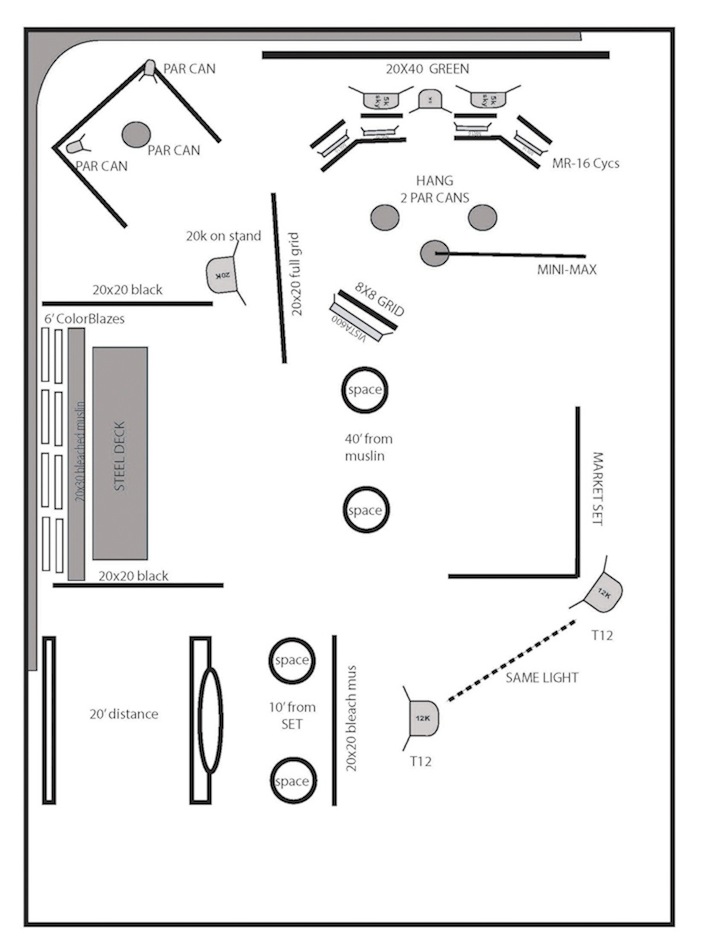
11AM – FRIDAY, BROOKLYN NAVY YARD
Shooting began at the Admiral’s building for Kenan’s amazing Ving Rhames-as-Pontius Pilate impression. First shot up: 23’ Technocrane sweeping up the columns to reveal Kenan, landing in a close up: “…I’m gonna get Old Testament on his ass.” A word about Technocranes, which is a crane with a telescoping arm (in this case we used a 23′ Scorpio Telescoping Crane, but any telescoping crane can be referred to as a “Techno” in my book). Yes – they cost more to rent than a normal, non-telescoping crane. And yes, they require additional specialized crew members to operate. But in my experience, the Techno pays for itself. First of all, it rolls off the trailer already built, as opposed to the massive tinker-toy setup of most other cranes that come in fifty pieces and require assembly onset – which always feels like it takes hours. Second, the speed at which you can execute moves on a telescoping arm far outpaces the speed of placing a traditional crane on track and physically moving the entire chasse around for every shot. On a shoot like this one, time saved using the Techno equaled overtime for the entire crew saved at the end of a very long day.
Camera-wise, I knew that Tarantino and Richardson are diehard film guys and all of their collaborations have been shot on 35mm filmstock with Panavision cameras and Primo anamorphic lenses…which is all a big no-can-do on our budget and schedule, so we went to the next best thing for a filmic look: the Arri Alexa. (Micro-overview: I like the Alexa for a filmic look, the Epic when I need 4K and high frame rates and the C500 when I need 4K, light-weight body and low-light performance). We had a set of Leica Summilux-C lenses but since we knew we would be snap-zooming as well, we had an Optimo 24-290mm. This was a 2-camera shoot so we actually had two Alexa bodies sharing the same set of lenses, with one of the cameras living on the crane with the zoom. The Alexa records internally to SSD cards in a few different flavors of ProRes. We always shoot ProRes HQ in Log-C color space. To emulate the anamorphic format of Tarantino’s films, we framed for 2:35 aspect ratio. I considered anamorphic lenses for about a half second, but I knew I would need the fast T1.4 stop on the Leicas; anamorphics tend to be slower and optically less-than-optimal if shooting faster than T2.8.
At the same location, we shot Taran Killam doing his uncanny Brad Pitt-as-Aldo Raine-as-St. Peter speech. This sequence was basically a shot-for-shot remake of the same scene from “Basterds”. Since I already had the camera on the Technocrane, I used the telescoping arm as a dolly, tracking with Taran as he marshals his Apostles, and then simply telescoping up to a high angle for the dramatic bird’s eye view opening of the scene. Again, the Technocrane proved to be a much faster solution than setting dolly track and a scaffolding or ladder for the high angle. Lighting-wise: I was prepared to light this scene with a 12K HMI through 12’x12’ muslin but the sun was doing an even better job so we shot with natural light.
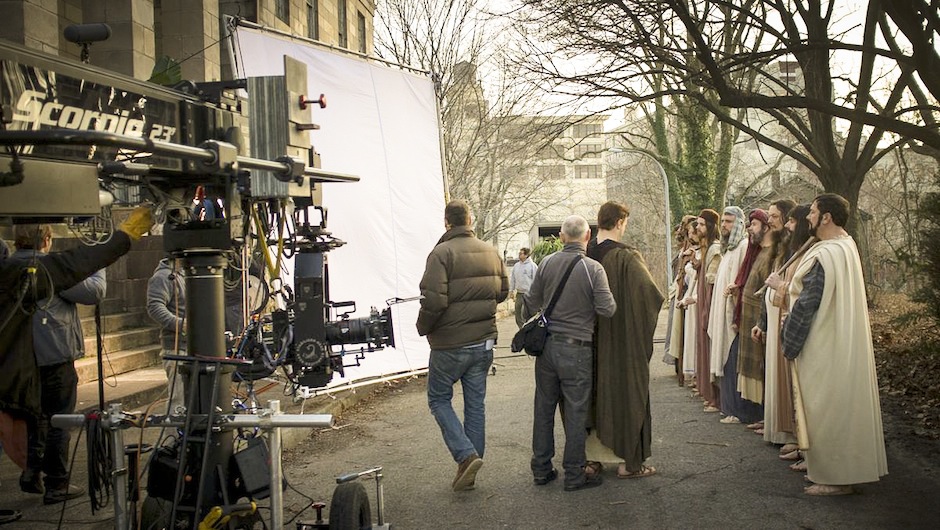
Next up: we loved the idea of getting a “Django”-style snap-zoom of Djesus riding into town on his white stallion but Christoph’s rehearsal schedule meant we’d never see him during daylight hours. Solution: we would shoot a wide shot with a photo-double and on the snap-zoom we would cut to a matching snap-zoom of Christoph on the same horse against a greenscreen on stage. I would be remiss if I did not mention that this horse shot was a huge bone of contention all Thursday during our prep. We technically had no business monkeying around with a horse on our insane schedule and with deep regret, Rhys agreed to give up the horse shot. It wasn’t until about 11pm on Thursday night as we reviewed the shotlist that Rhys decided he MUST have the horse shot. He stuck to his guns and made it happen – and it really up’ed the ante on the whole spot. That’s a great lesson that sometimes you have to ignore your warning light and just go with your gut. The “horse shot” is now short-hand for us, referring to a seemingly impossible shot that we’re still gonna go for, logic be damned.
About a hundred yards from the Admiral’s building was an old dilapidated warehouse that we thought would be perfect for the “Apostles-as-Basterds” montage of Roman-killing. By this point we were running out of daylight so we rushed our shots, using a Kino VistaBeam 600 through a 4×4 frame of 216 to give the fading natural light some shape.
6PM – FRIDAY, STEINER STUDIOS
Once we lost daylight we made the move a few hundred yards away to our stage at Steiner, where my rigging crew had transitioned into my shooting crew and the stage was relatively pre-lit. We had a handful of shots we could get with our Djesus photo-double, and then Christoph would finally arrive for his shots.
First up we shot the silhouette sword-fight scene, modeled after the Crazy-88 fight scene from “Kill Bill Vol 1”. The idea was simple enough: primary colored background silhouetting a foregrounded fight scene. We had a team of stunt guys practicing a sword fight routine for a few hours so they were good to go. Problem was, my lighting plan was a total FAIL. Let me step back and explain: I sometimes have the pleasure of working with an amazing lighting designer named Mike Baldassari. Mike lights Broadway shows and also the big budget movie-versions of Broadway shows, like NINE and ROCK OF AGES. When he’s not doing that he is sometimes available to help me when I need a theatrical look. He’s taught me a lot about theatrical-lighting and how it’s completely different from cinematic-lighting. Different tools, different techniques, even a different color wheel. Generally speaking: theatrical lighting uses the additive color wheel, mixing red/green/blue primaries to create colored light, whereas cine-style lighting is based on the subtractive color wheel via gels and filters to create color by subtracting wavelengths.
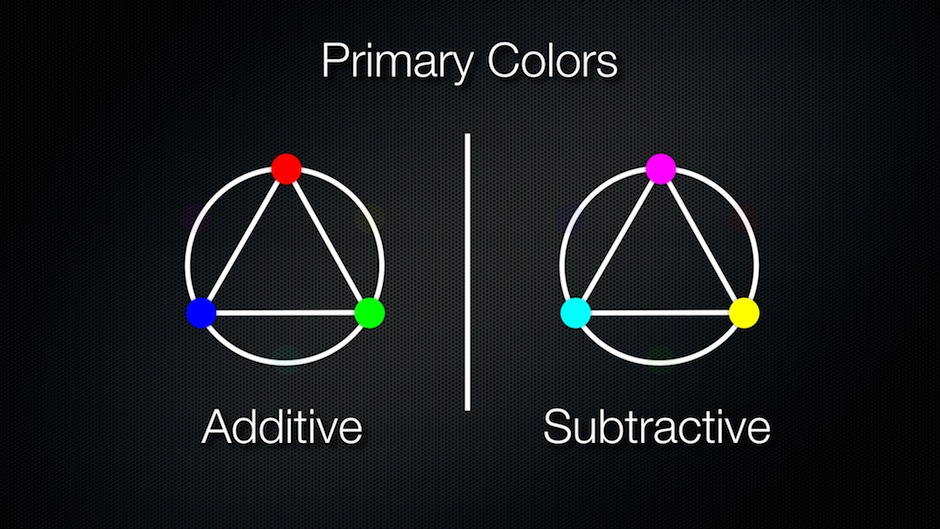
Point is: Mike was not on this job but I thought I would try my hand at theatrical lighting without him. To create the huge primary-color background, we hung a 20’x30’ bleached muslin and lined the top and bottom with 6’ DMX-controlled ColorBlaze LED strips – just like how we lit our recent “Charlie Brown Christmas” spot. By using LED color strips, we could quickly and easily change the color of the entire 40’ wall with the touch of a button. The idea is to skim the LED light up and down the surface of the muslin, creating a perfectly uniform wash of color. At least that’s what happens when Mike is on the job…In this case, I was looking at a mostly dark muslin with patches of spotty colored light – and I panicked: why isn’t this working?! Turns out the rental house sent us a combination of two different types of LED strips: ColorBlaze and ColorForce – and the mixture wasn’t playing nice. Well, we were out of time and had to shoot so I needed a quick fix. Amazingly, our production manager Justus McLarty happened to take a peak behind the muslin at the white cyc stage wall and said, “hey – this looks pretty good back here…”. We pulled the muslin down and discovered that while the whole ‘skip the light up the muslin’ idea wasn’t working for us, we had (inadvertently) lit the cyc with colored light! It wasn’t as saturated or even as the muslin would have been, but this was a huge stroke of luck and we were able to start shooting moments later. We staged the scene on an 8″ steel deck surfaced with 4’x8′ sheets of glossy masonite to reflect the silhouette while hiding the bottom row of LEDs. The choreographed sword fight looked great, with splatters of blood added in post.

“Kill Bill Vol 1” versus “Djesus Uncrossed”
Next up: Djesus rises from the grave. The tomb and tombstone were made out of sculpted foam and probably looked pretty fake in broad daylight, but with dark, contrasty lighting, they looked totally authentic. I simply setup a 20’x10’ unbleached muslin with a T12 Fresnel blasting into it, right at the camera. The warm, soft light punched around the edges of the stone, just like desert sunlight.
10PM – FRIDAY, STEINER STUDIOS
By this point, Christoph Waltz had arrived on set for the reverse shot – revealing Christoph-as-Djesus exiting his tomb and then snap-zooming back to a wide shot on, “Guess who’s back.” I used two 6k spacelights to light a broad area as if from skylight. We setup across the stage and zoomed in, then just manually snapped out wide. No need for greenscreen around the cave – our compositor, Todd Sarsfield, would just blend the edges of our small cave into the background plate of a mountainside. I say all this in hindsight; at the time I was thinking: uh…this is gonna work, right??
Then we invited our horse to join us onstage to shoot with Christoph against a greenscreen – and here was my next terrible idea. My theory was that the LED-lit muslin would work perfectly as a greenscreen; all we had to do was dial-in green on the DMX mixer. But since the muslin was a total bust, we were now stuck with the LEDs lighting a white cyc – and instead of a perfectly smooth, saturated key screen, I had created a spotty, pale yellow-green wall. Well, that’s how we shot it and it was up to our poor compositor to somehow make it work – and I still feel embarrassed about it…sorry about that, Todd!
For the Market scene where Djesus mows down Roman soldiers, I lit this set very broadly with another two space lights and a huge 20K Fresnel through a 20’x20’ unbleached muslin, which created a super soft, warm light. For a backlight, I had a T12 Fresnel on a small articulating lift, reaching out over the set. For the bullet-hits, our SPFX guy, Richie Tache, was shooting paintballs filled with zirconium – called “zirc hits” — that create a big spark on impact. Then we rolled in the Technocrane and I thought: wow – is this still just a parody shoot? This had officially become the biggest production I’d ever worked on at SNL…
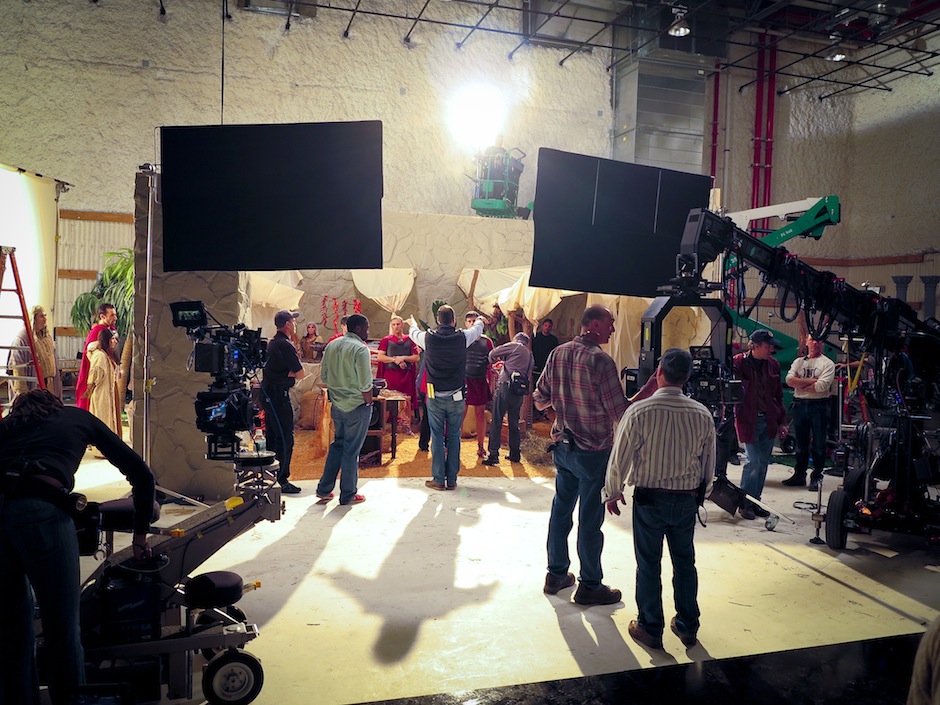
We lit the Roman Council Chamber with the same lighting setup: 20K into 20’x20′ unbleached muslin. The set was designed with a balcony opening up to a greenscreen – which would be composited with an exterior plate so I also had a 9-light maxi hung up very high on the grid as a sunny backlight. For the reverse shot on Djesus, we simply flipped the actors around on the same set, closed the gap to hide the greenscreen, and I had pre-rigged 6′ MR-16 cyc strips with Magic Gadget flicker boxes to emulate flickering torchlight.
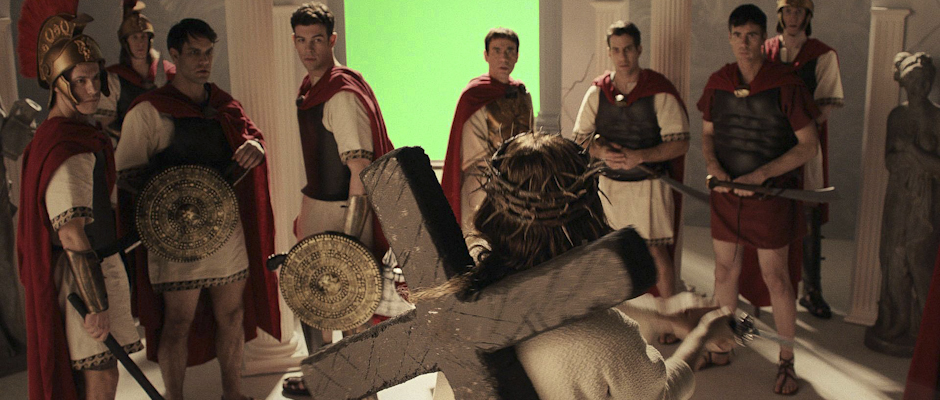
As for the amazingly grotesque and oh-so-Tarantino splitting of Fred Armisen’s head following the punchline, “…the ‘H’ is silent…” — I’ve said it before: we have the best Makeup Department in the biz. This prosthetic was made by our Key Makeup wizard Louie Zakarian in less than a day.
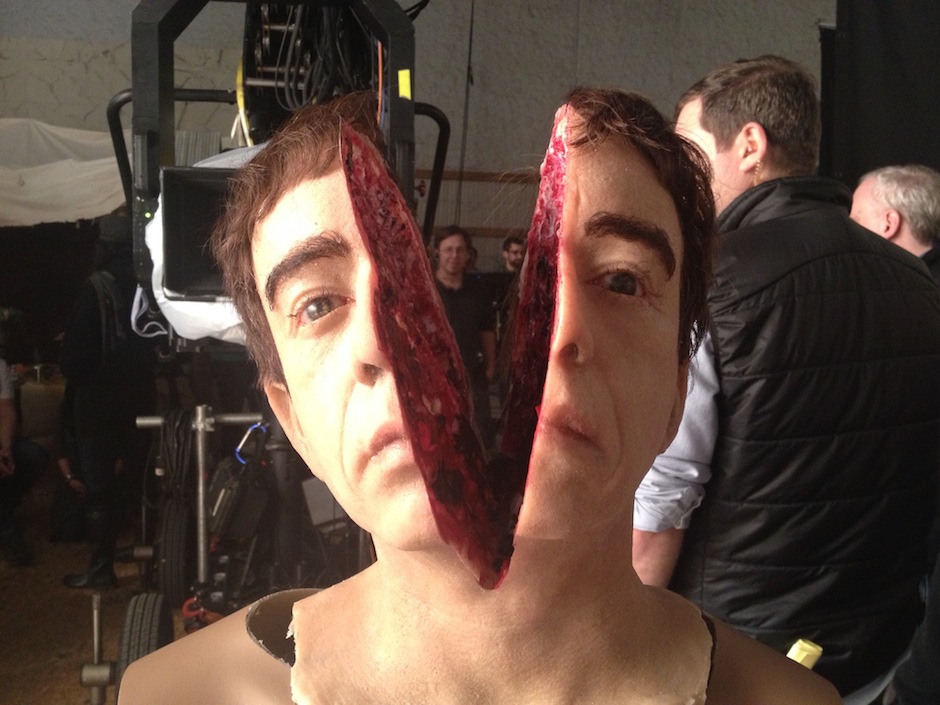
4AM – SATURDAY MORNING, STEINER STAGES
We’re on our last big setup – the squib-shot where Djesus shotgun blasts a huge hole in Judas Iscariot. How we got to this point is all a blur. Everyone is completely exhausted and running on fumes. We had just released Christoph, who had to rehearse more live sketches and then host the show later this same day. This is our only squib shot in the entire spot and it seems to take forever to setup. We’re only going to do it once so we set both cameras at 120fps and Rhys tells our SPFX guy to just go for it – full load, extra large blood pack. My 1st AC, Nick Demas, covers every inch of our cameras with plastic bags because the blood is gonna spray everywhere. The blast goes off perfectly and even in our punch-drunk state, everyone gleefully gathers around the monitors to celebrate the glorious slo-mo action. The shot looks great and by 4:30am we hear the magic words…THAT’S A WRAP ON DJESUS!
What happened over the course of the next 15 hours is a whole other miracle. Somehow Rhys and editor Adam Epstein transformed our 20+ hour shoot day into a finished trailer, and colorist Emery Wells added the final gloss. I think just seeing Adam’s Premiere timeline tells the story (and makes a pretty cool piece of pop art all on it’s own!)
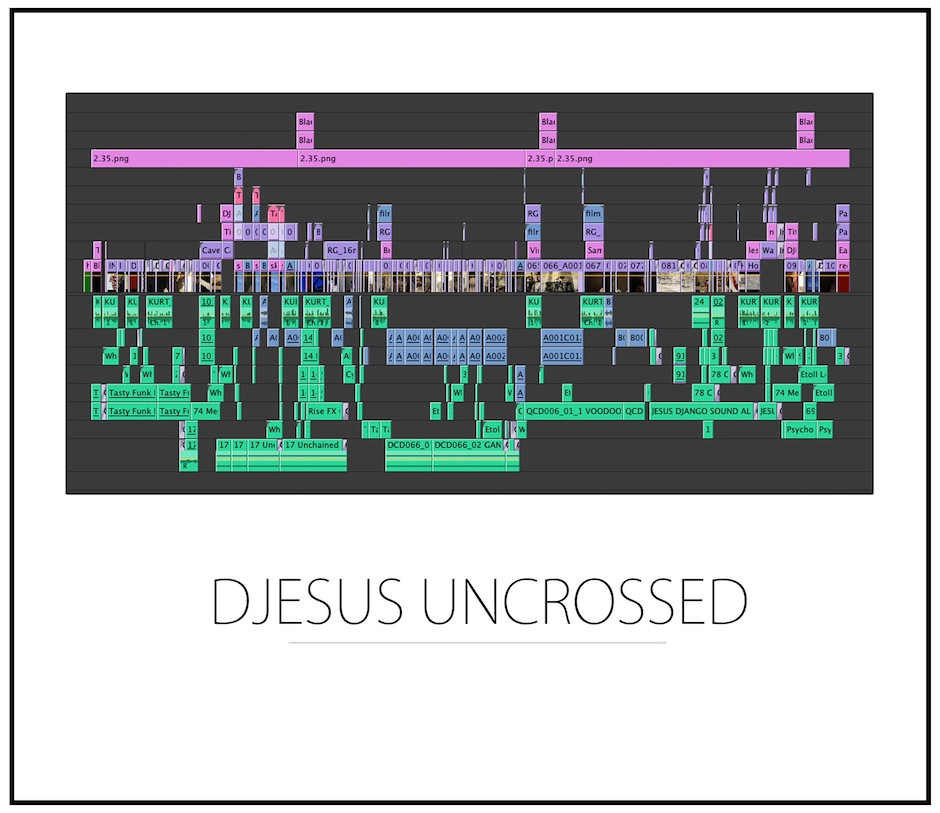
I watched the spot air live that same night from my home in Venice, California and I felt incredibly lucky for the opportunity to work on such gonzo scripts, and incredibly proud to work with such a great team. Then I finally went to bed.
*****
If you’re interested in learning A LOT MORE about how I like to work, check out my workshop tour this summer. It’s called the VISUAL STORYTELLING TOUR and I’ll be visiting 31 cities between June and July.

